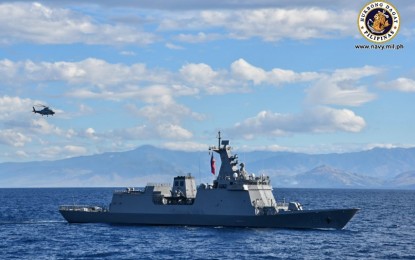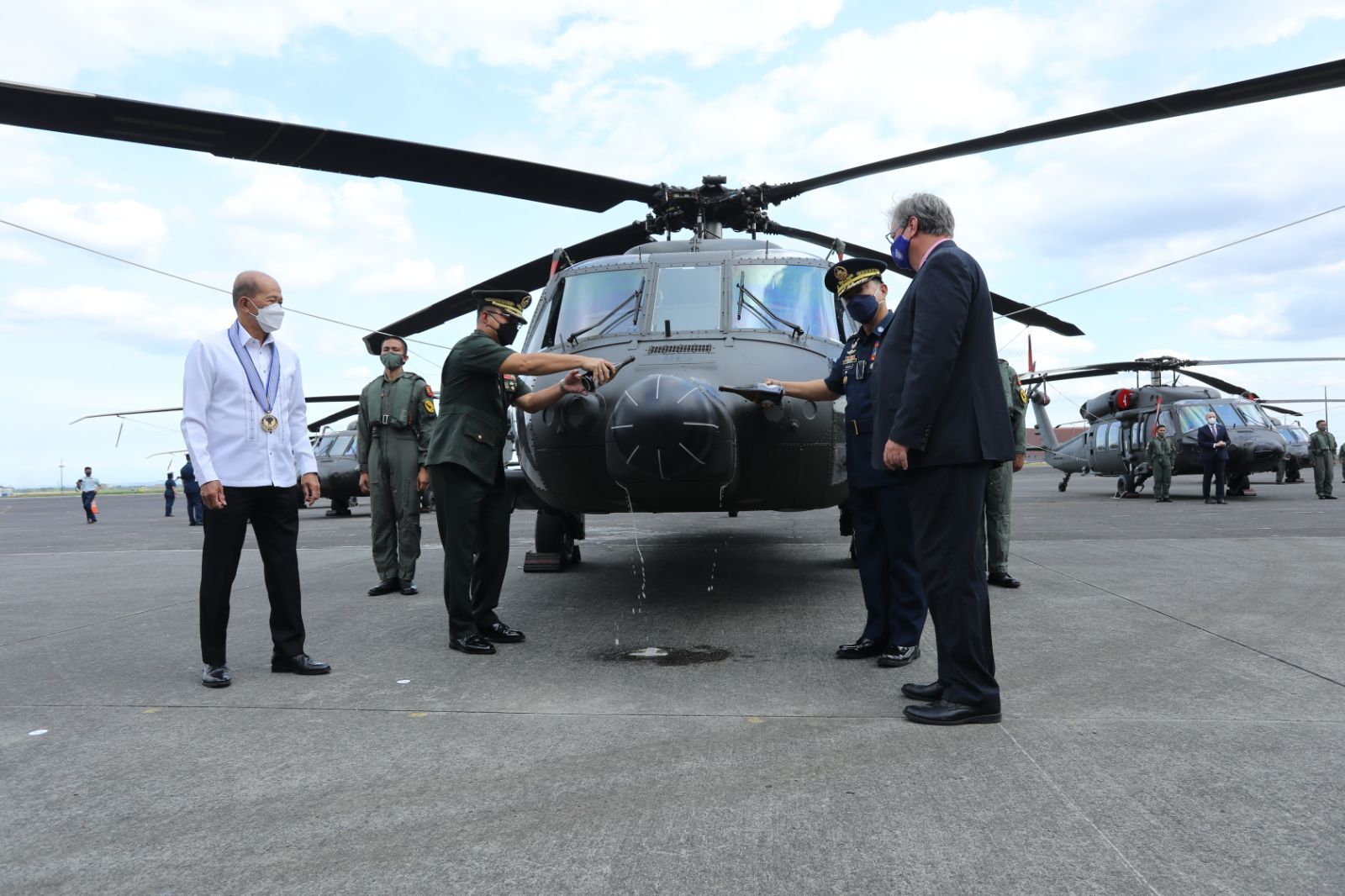
BRP Antonio Luna (Photo courtesy of Philippine Navy)
MANILA – While the country continues to pick up from the effects of the coronavirus pandemic, the Philippine Navy (PN) managed to continue with significant upgrades that will further enhance its capability to protect the country's waters.
This year, the country got its second missile frigate, the BRP Antonio Luna (FF-151), and was commissioned along with several equipment whose funding source has been assured.
BRP Antonio Luna arrived in the country last February 9 and was formally commissioned at Pier 13, Manila South Harbor on March 13.
The frigate, along with its sister ship, BRP Jose Rizal (FF-150), is capable of surface, sub-surface, air, and electronic warfare using state-of-the-art electronic sensors, long-range missiles, acoustic-guided torpedoes, and an embarked anti-submarine helicopter.
The BRP Antonio Luna entered the waters of Capones Island, Zambales last February 9, four days after leaving the Hyundai Heavy Industries (HHI) shipyard in Ulsan, South Korea on February 5.
The ship also sailed in formation with BRP Jose Rizal (FF-150), through Manila Bay before proceeding to its anchorage area in Subic, Zambales.
The first frigate, BRP Jose Rizal, was delivered and subsequently commissioned last July 10.
The BRP Antonio Luna's keel-laying ceremony on May 23, 2019, coincided with the launch of BRP Jose Rizal.
The contract for the two ships was placed at PHP16 billion, with an additional PHP2 billion for weapon systems and munitions.
Then PN flag-officer-in-command, Vice Adm. Giovanni Carlo Bacordo, said these newly acquired guided missile frigates play a vital role in naval diplomacy and in promoting the country, apart from helping protect its vast waters.
"They will also play a big role in naval diplomacy to promote our country and showcase our strength by not only participating in multi-lateral maritime training activities, but also conducting port visits in selected key areas of our allied navies," he said.
The BRP Jose Rizal and BRP Antonio Luna will be deployed only to specific missions as ordered by the Armed Forces of the Philippines' top leadership, he added.
"They will still conduct sovereignty patrols and show-the-flag missions covering the whole archipelago with focus on external defense. They will participate in naval exercises here and abroad in order to hone the skills of her crew in naval warfighting," Bacordo said.
Frigates now armed with surface-to-air missiles
On October 10, the PN announced that the Mistral 3 surface-to-air-missiles (SAMs) of the country's two guided-missile frigates were finally delivered at the Subic Bay International Airport in Bataan last October 8.
Navy spokesperson Commander Benjo Negranza said the SAM will provide the two frigates with anti-air capabilities or the ability to shoot down aerial threats.
Procurement and delivery of the Mistral 3 SAMs is part of the PN Frigate Acquisition Project Lot 2B which was awarded to MBDA Missile Systems based in France.
"Surface-to-air missiles are among the primary weapons of FF-150 and FF-151 that bolsters the PN’s anti-air warfare capability. The arrival of these missiles will greatly capacitate our JRC (Jose Rizal Class) frigates in the conduct of their maritime operations," Negranza said.
Meanwhile, the PN Frigate Acquisition Lot 2A for the JRC's surface-to-surface missiles is scheduled for deliveries in March 2022.
South Korean defense manufacturer LIG Nex 1 is the company that would deliver C-Star missiles which is considered the main surface-to-surface weapon of the JRCs.
The C-Star is described as a "sea-skimming surface-to-surface anti-ship cruise missile".
FAIC-M on the way
Meanwhile, two of the eight units of fast attack interdiction craft-missile (FAIC-M) ordered by the PN from Israel Shipyards Ltd are expected to be delivered in the last quarter of 2022.
"The first two units of the FAIC-M (are) estimated to arrive in-country around the last quarter of 2022," Negranza earlier said.
He added that the acquisition of eight units of FAIC-Ms is among the 2019 projects approved by President Rodrigo Roa Duterte under the Horizon 2 List of the Revised Armed Forces of the Philippines Modernization Program.
Negranza said the FAIC-M project was awarded to Israel Shipyards Ltd. and Rafael Advanced Defense Systems of Israel under a government-to-government procurement scheme and is divided into two lots.
"Lot 1 covers the delivery of nine platforms, four of which will be missile-capable, and the upgrading of the Naval Shipyard (NSY) for the establishment of a local production line as part of the Transfer of Technology (ToT). On the other hand, Lot 2 includes the integration of weapons and combat systems," he added.
The FAIC-M Project Contract was signed on Feb. 9, 2021 while the Notice to Proceed was signed last April 27.
The FAIC-M project, which is worth around PHP10 billion, had its Notice of Award issued on Jan. 5, 2021.
Reports said the Israeli shipbuilder will be supplying its Shaldag Mark V for the Navy's FAIC-M project.
Bacordo earlier said successful negotiations with the Israeli shipbuilder resulted in the addition of one Shaldag Mark V unit to the eight boats initially ordered without any extra cost to the Philippine government.
The FAIC-M is expected to replace the force of patrol killer medium (PKM) or medium-sized patrol craft.
Four of the FAIC-M will be armed with NLOS missiles with pinpoint accuracy and a range of 25 kilometers while the other four will be armed with machine guns and light automatic cannons.
Once deliveries of the FAIC-M are completed, these vessels can interdict surface threats and launch non-line-of-sight missiles safely using the surrounding littoral areas as maneuver space and cover.
It is also expected to complement the PN's fleet of 12 multipurpose attack craft (MPAC) previously acquired to secure the country’s coastal waters and maritime territories.
"This acquisition aims to strengthen the country's naval capability in terms of enhancing littoral defense and maritime interdiction operations as it will complement the previously acquired 12 MPAC of the PN," Negranza said.
Three of the MPACs are armed with the Rafael Advanced Defense Ltd. Spike-ER (extended range) surface-to-surface missile system while three more are scheduled to be installed with the same weapon system.
P62-B for additional 'Black Hawk' choppers, OPVs
On December 7, Defense Secretary Delfin Lorenzana announced that the government has allocated a total of PHP62 billion for the acquisition of 32 more Polish-made S-70i "Black Hawk" combat utility helicopters for the Air Force and six offshore patrol vessels (OPVs) for the PN.
"Newly approved funding for capital assets acquisition: 32 units 'Black Hawk' helicopters- PHP32 billion and six units of OPV -PHP30 billion," he said.
When asked where the country intends to acquire the additional helicopters and OPVs, Lorenzana replied: "OPV with Austal (the Australian defense manufacturer and shipbuilder) and 'Black Hawk' from PZL Mielec, Poland."

He, however, clarified that there is still no contract yet issued for these assets and “still under negotiation.”
The Philippine Air Force (PAF) earlier completed the acquisition of 16 "Black Hawk" helicopters from Polish company PZL Mielec worth USD241 million (about PHP11.5 billion).
The first batch of six "Black Hawk" helicopters was delivered in November 2020, followed by the second batch of five in June that was formally accepted, turned over, and blessed in a simple ceremony on October 13.
The last batch of five choppers was delivered on November 8 and formally accepted by the PAF on December 3. One unit from the initial six units delivered in the country crashed last June 24 while on a night-flying exercise.
The PAF's newly-acquired S-70is were deployed to transport Covid-19 vaccines in remote areas around the country.
Earlier, Lorenzana said Austal, which has a shipyard in Balamban Cebu, remains at the forefront in the ongoing procurement for OPVs for the Navy.
The OPV project is expected to replace the World War II surface assets decommissioned by the PN After the OPVs, another project for the PN is the procurement for two modern corvettes, which is the smallest surface combatant capable of engaging submarines and other vessels.
Funds for corvette acquisition assured
On December 14, Lorenzana expressed delight after the Department of Budget and Management (DBM) released the Special Allotment Release Order (SARO) for the 15 percent advance payment for the PN's Corvette Acquisition Program (CAP).
"We have been waiting for this for the procurement process to proceed," he said when asked by the Philippine News Agency for a reaction after the DBM released the SARO to the DND last December 10.
The SARO worth PHP3.75 billion is intended to "cover the funding requirements for the 15 percent advance payment for the CAP of the PN under the Revised Armed Forces of the Philippines Modernization Program."
Lorenzana also said there are still several steps to be done before the contract is signed.
"Our target is before the year ends," he added.
With this development, Lorenzana said the DND can go on with the finalization of the CAP contract.
The budget for the CAP, which consists of two modern corvettes capable of anti-ship, anti-submarine, and anti-air warfare missions, is placed at around PHP28 billion. It will also be equipped with a variety of sensors to allow it to conduct such missions.
The acquisition of these two missile-armed corvettes was done to backstop the two brand-new frigates acquired from HHI.
"They are smaller than the (two Jose Rizal-class frigates) but will also be sufficiently armed," Lorenzana said when asked for a description of the ships.
The two Jose Rizal-class frigates measure 107 meters and weighs around 2,600 tons.
Earlier, Lorenzana said while the country has yet to sign a contract with HHI for the two corvettes, the PN is recommending that the company be the one to build these ships for commonality and interoperability.
"(The contract for the) corvette(s), di pa naman napirmahan sa Hyundai, pero yun ang gusto ng Navy dahil para iisa lang ang gagawa ng ating frigates tsaka 'yung corvettes. Para yung sistema nila is pare-pareho, yung mga parts, whatever, interoperability para kung may [masira], madali lang ma-repair (these have yet to be signed by Hyundai, but this is what the Navy wants so that there is only one maker of the frigates and the corvettes. So that their system is the same, the parts, whatever, interoperability, in case something is damaged, it is easy to repair)," he added. (PNA)
